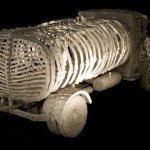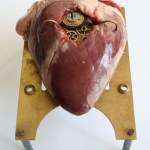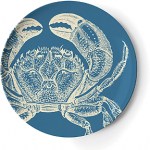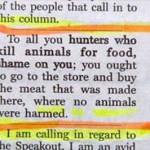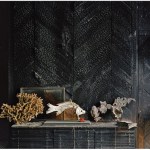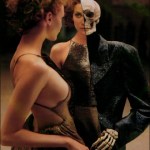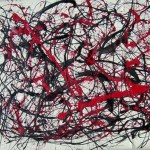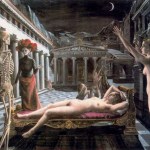
What's that you say? You still haven't joined Twitter? You don't see the point of constant 140-character status updates? Well, that's suddenly okay! You can emulate the many developing third-world nations who leaped directly over landline telephones to cell networks, and bypass Twitter entirely for the next big thing: Flutter.
Now what we really need to do is figure out ways to harness Flutter to replace the mainstream media and transform science. Imagine lab goggles with your friends' "flaps" scrolling across them: you'll never need to leave the bench to "have a life!" w00t!
Via…
Bora's comment on my previous post (Could beautiful design save newspapers?) got me thinking about the distinction between aesthetics and advertising. Here's one Twitter-worthy take on it:
Available at the Grandburo online store.
Via Kingdom of Style
New anatomical DIY project: get a CT scan, remix it to music, and post it on the web! That's what Jaymis did:
Inside The Jaymis: Skeleton Animation - Wide Time from Jaymis on Vimeo.
I got an MRI recently, but they didn't give me the results on a CD, so I can't do this. Now I feel all left out. Nevertheless, it's kind of odd looking at someone else's innards on a Sunday morning over tea. . . is this DIY TMI?
Via Andrew Sullivan.
It's just not Google's week. A mob of angry villagers north of London formed human chains and chased off the Google Maps car (no word whether they had torches). Microsoft is all up in Google's business (to be precise, they're funding a team at New York Law School's Institute for Information Law and Policy, led by a former Microsoft programmer, which is weighing in on the pending settlement of Google's book-scanning lawsuit). And it's not just Microsoft that's taking aim at Google: the NYT has an overview of the many parties, from librarians to law professors, who have serious doubts about…
Aquasaurus
paint, resin, steel
Jitish Kallat, 2008
At first I thought this piece by Indian artist Jitish Kallat was an oil tanker truck, and that it represented some sort of play on "fossil fuels" (and perhaps the morbidity of the behemoth domestic auto companies). But apparently that was my American bias at work.
It's actually a water tanker, entitled Aquasaurus, and it represents the rapid transformation of urban India:
Aquasaurus is a monumental seven-metre long skeletal sculpture of a water-tanker morphing to become prehistoric creature that personifies the radical transformation of…
At 3quarksdaily, Sam Kean has an interesting essay on the future of theoretical mathematics, whether computers capable of generating proofs will supplant human mathematicians, and what that will mean for the "beauty" of math:
There's general consensus that really genius-level mathematics is beautiful--purely and uncorruptedly beautiful, the way colored light is, or angels. More particularly, it's regarded as beautiful in a way that science is not. With a few exceptions--Einstein's theories of relativity, string theory, maybe Newton and Darwin--no matter how much science impresses people, it…
Fixed Heart
offal with mixed metal components
Lisa Black, 2008
I blogged about New Zealand artist Lisa Black before, but I can't get over this great piece of hers. What does it signify? Does it represent the gradual replacement of the natural world around us with technology, to the point where our own bodies become artificial? Is it critiquing the reductionist tendencies of neurobiologists who believe our deepest emotions are complex but purely chemical reactions? Is it a steampunk Valentine? I don't know, and I don't really care - it's just cool.
Check out more from Black here.
Lately, I've been seeing a lot of dinnerware that's just too fascinating to cover with food. Like Hiroshi Tsunoda's Bodylicious plates, available at DesignCode. According to Street Anatomy, Tsunoda was
inspired by Nyotaimori, a tradition where food is presented on a naked woman's body and used as a tray. Nyotaimori is also referred to as body sushi, and requires the person to practice laying for hours without moving.
Wow, I'm not sure what to say. But at least the plates are equal opportunity: there's a Bodylicious Y set too!
Moving from Homo sapiens to marine invertebrates, these…
I've been as eager as a brain-starved zombie to get my hands on Pride and Prejudice and Zombies, the Jane Austen mash-up concocted by Seth Grahame-Smith for Quirk Books. It sounded a like Regency Buffy: zombie-slaying Lizzy Bennet indulges in arch quips while skewering zombies and ninjas with her Katana, all in time for the Netherfield ball. The obvious question was, could this conceit actually work for the length of a novel?
The answer: yes - sort of. P&P&Z is no Buffy. But it will be entertaining for a particular type of reader: those who are familiar with the original novel, yet…
Jacek Utko argues that there is no convincing reason why newspapers should survive - but that good design might be able to transform them into something more successful. In addition to numerous awards, Utko's fearless use of white space, bold color, and dramatic imagery has won significant increases in readership (up to 100%) for several Eastern European newspapers.
A real newspaper redesign involves more than changing the layout. The layout is essential, but by no means the only element. First we define the goal, later the necessary content-changes, and only then do we get to design.…
My friend John Ohab is hosting a new DoD webcast called "Armed With Science." Sure, it has an over-the-top logo reminiscent of the Syfy Channel (I like to intone "ARMED WITH SCIENCE" with the same cadence as "PIGS IN SPACE!"), but the show turns out to be really well-done and interesting. Each episode is a half-hour interview with a researchers in a scientific field relevant to the military: sometimes that means SONAR or geopositioning, but they also take on general science topics like Brain Awareness Week at the National Museum of Health and Medicine. It's a nice mix of topics, and it's…
SEEDmagazine.com interviews Carl Bergstrom, whose eigenfactor project uses citation databases to map networks of information sharing within science:
We find papers to read by following citation trails. If you have an eigenfactor of 1.5, it means 1.5% of the time, a researcher following citation trails is actually trying to get an article from your journal. . . How do you make the right connections, right? How do you make the critical connections to move thought forward? If you can solve a problem like that, or even just make a little contribution to it, it really accelerates science in a…
Continuing the current discussion of the questionable quality of popular science journalism, British researcher Simon Baron-Cohen weighs in at the New Scientist with his personal experiences of misrepresented research. Baron-Cohen complains that earlier this year, several articles on his work linking prenatal testosterone levels to autistic traits, including coverage in the Guardian, were titled and subtitled misleadingly:
It has left me wondering: who are the headline writers? Articles and columns in newspapers are bylined so there is some accountability when they get things wrong. In this…
From Failblog.
(I dedicate this to Hungry Hyaena, who holds extremely nuanced views on the ethics of hunting, and would no doubt have an easier time if he embraced complete denial, like this poor person).
Norwich State Hospital, Piano
"New England Ruins"
Rob Dobi, 2005
Three quietly stunning collections of photos mix the ache of loss with the unintentional but undeniable beauty of decay. First, Rob Dobi's "New England Ruins" documents abandoned buildings in various states of abandonment. His compositions vary from grand (abandoned stages and performance halls) to mundane (a chair fallen down a flight of stairs, the back of a derelict television). Norwich State Hospital, Piano (above) captures a broken piano, its innards undulating like the skeleton of a grilled trout, under a crude mosaic of…
Photo by Tracy Woodward, WaPo
Yesterday, zookeepers at the National Zoo's Conservation and Research Center discovered two newborn clouded leopard cubs in the enclosure of their mother, Jao Chu. This is a big deal because it is notoriously difficult to breed clouded leopards in captivity: males can attack and kill females with whom they aren't properly bonded, and captive mothers often inadvertently or deliberately kill their cubs. Because of that risk, these two cubs were taken from Jao Chu to be raised by human researchers.
Jao Chu and her mate Hannibal were imported from Thailand last…
Richard Avedon, The New Yorker, 1995
Via Haute Macabre, an unbelievable fashion editorial created by Richard Avedon for the New Yorker. I have no words.
Richard Avedon, The New Yorker, 1995
See the complete editorial at Haute Macabre.
It's Ada Lovelace Day!
Ada Lovelace (1815 - 1852) is often referred to as the world's first computer programmer. The daughter of the famous poet Lord Byron, and the admired intellect, Annabella Milbanke, Ada Lovelace represented the meeting of two alternative worlds: the romanticism and art of her father versus the rationality and science of her mother. In her attempt to draw together these polar opposites and create a 'poetical science' during the Victorian age, Ada collaborated with the renowned mathematician and inventor, Charles Babbage. (source)
I'm betting famous names like Marie Curie…
The Sleeping Venus (1944)
Paul Delvaux
Observatory is a new collaborative art space located in Brooklyn, where it is reportedly sandwiched between Proteus Gowanus, Cabinet Magazine, and the Morbid Anatomy library. Its illustrious proprietors include Pam of Phantasmaphile, Joanna of Morbid Anatomy, and D&M of Curious Expeditions. And if that's not reason enough to be excited, tonight they are hosting a talk by Kathryn Hoffmann of the University of Hawaii at Manoa, entitled "Reveries of Sleeping Beauty: Slumber and Death in Anatomical Museums, Fairground Shows, and Art."
I saw Dr. Hoffmann…
Mrs. Bennett
circa 1818-1821
Wellcome Library
While browsing Morbid Anatomy recently I did a double take: is that the hypochondriac matriarch of Pride and Prejudice, only zombified? No, Lizzy's mother has not succumbed to the unmentionable scourge - yet. This Mrs. Bennett is a coincidentally named Georgian lady who suffered from an unnamed skin ailment, from which she fortunately makes a full recovery. You'll have to wait until my April 1 review of P&P&Z to discover if the Bennets of Longbourne are so lucky!

